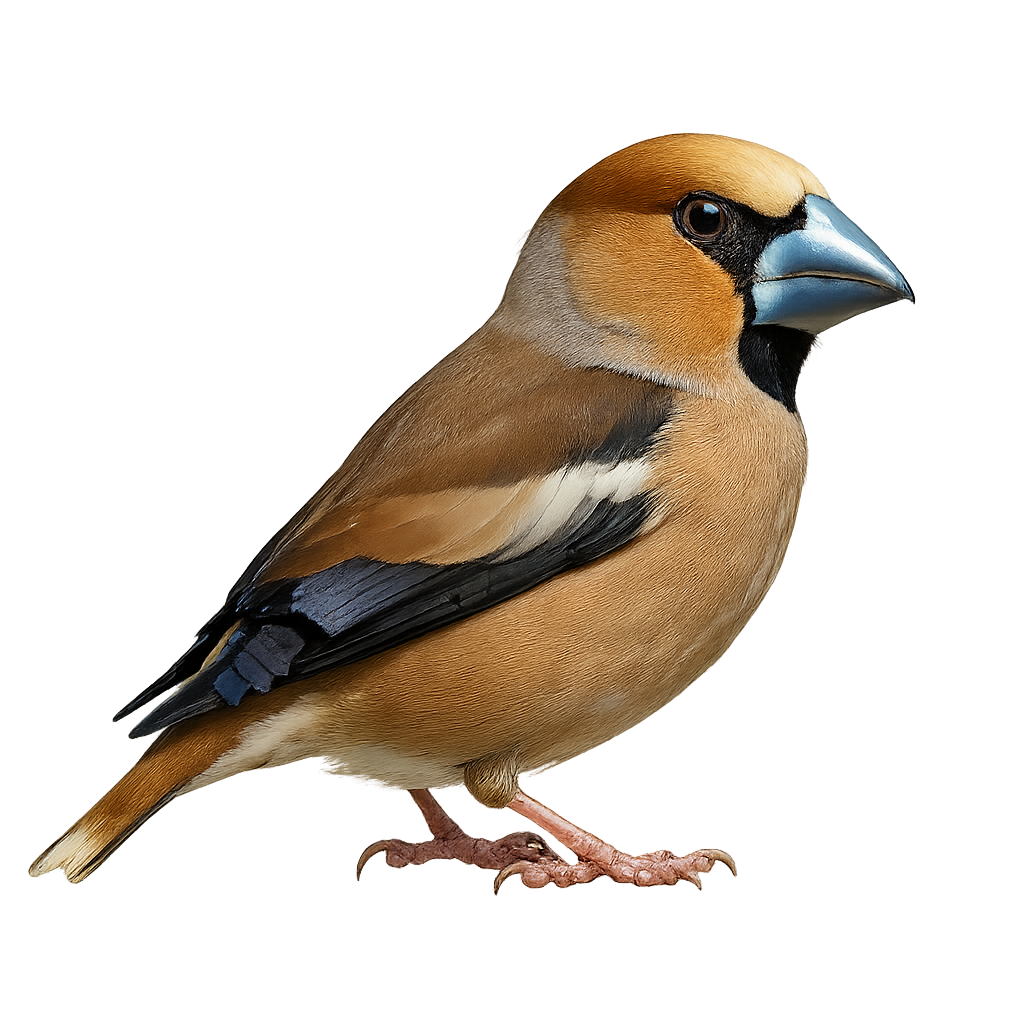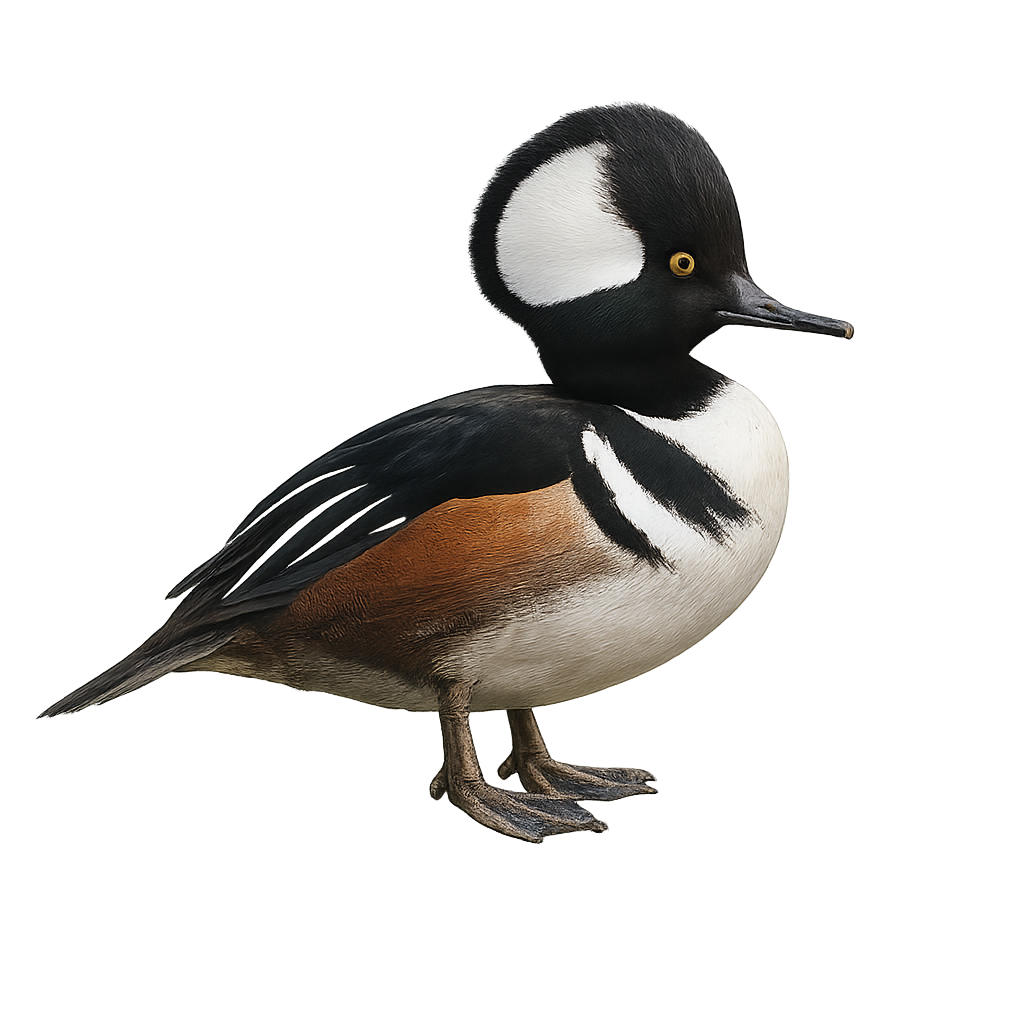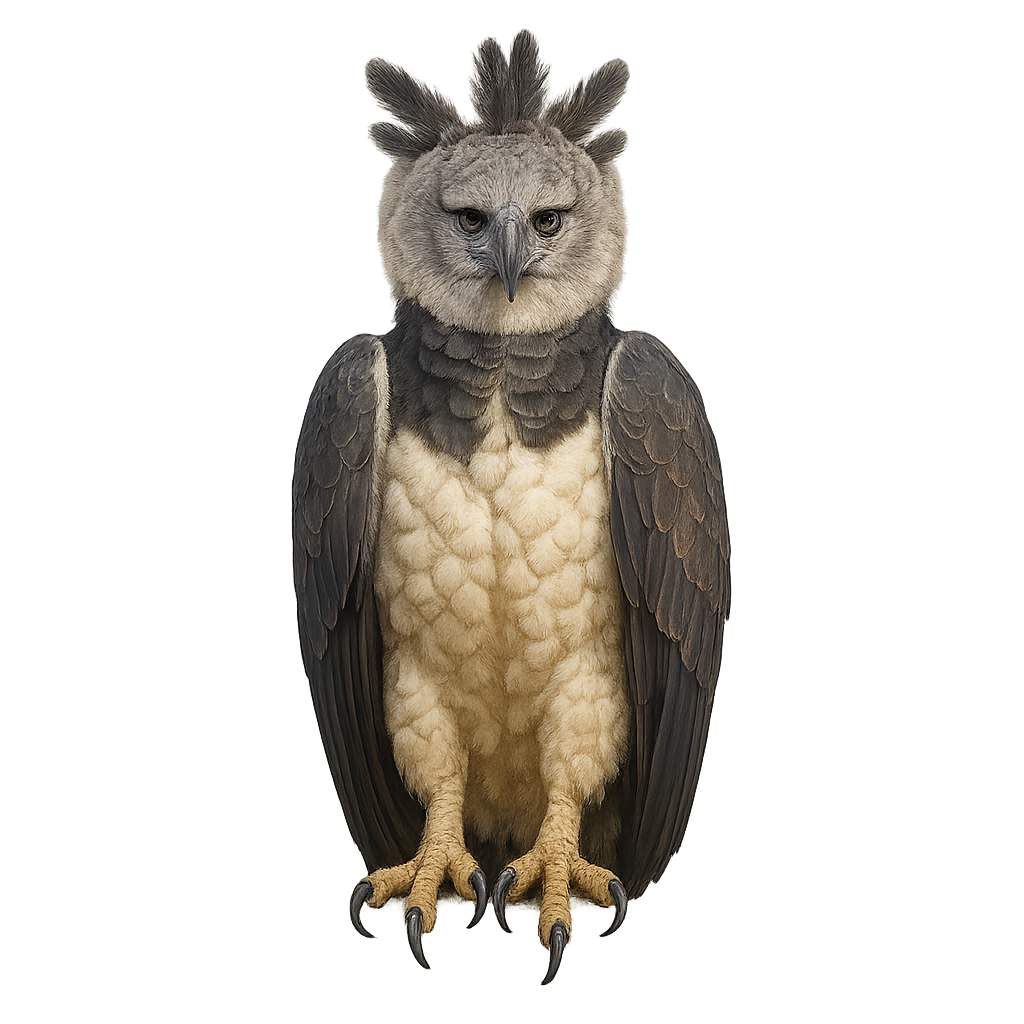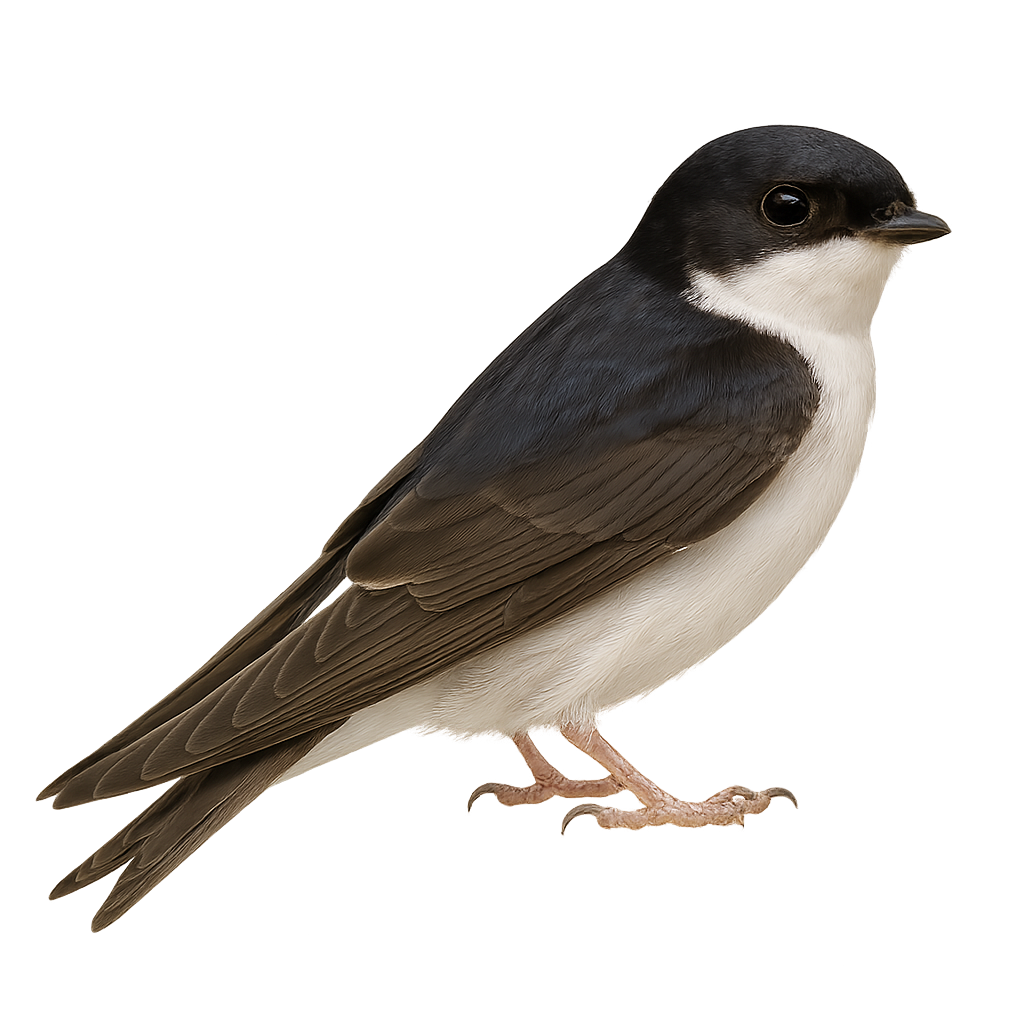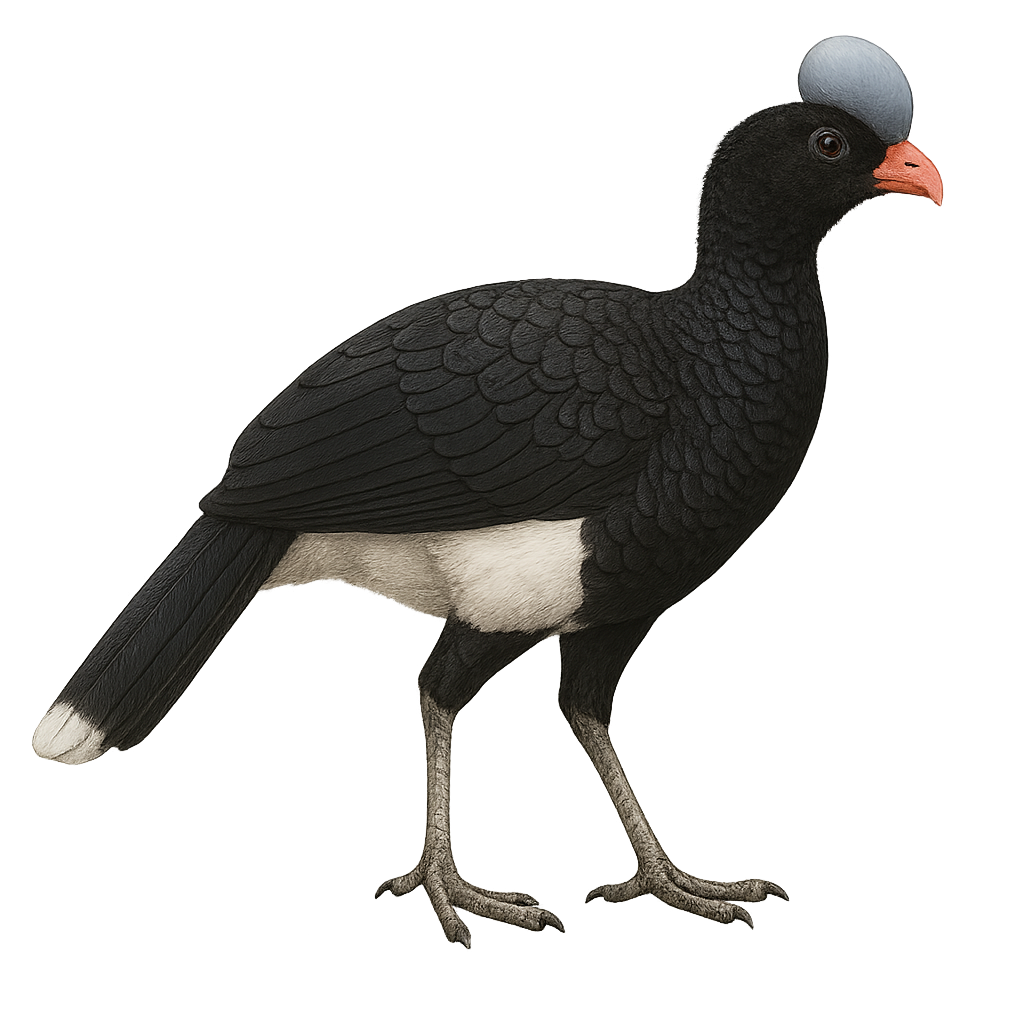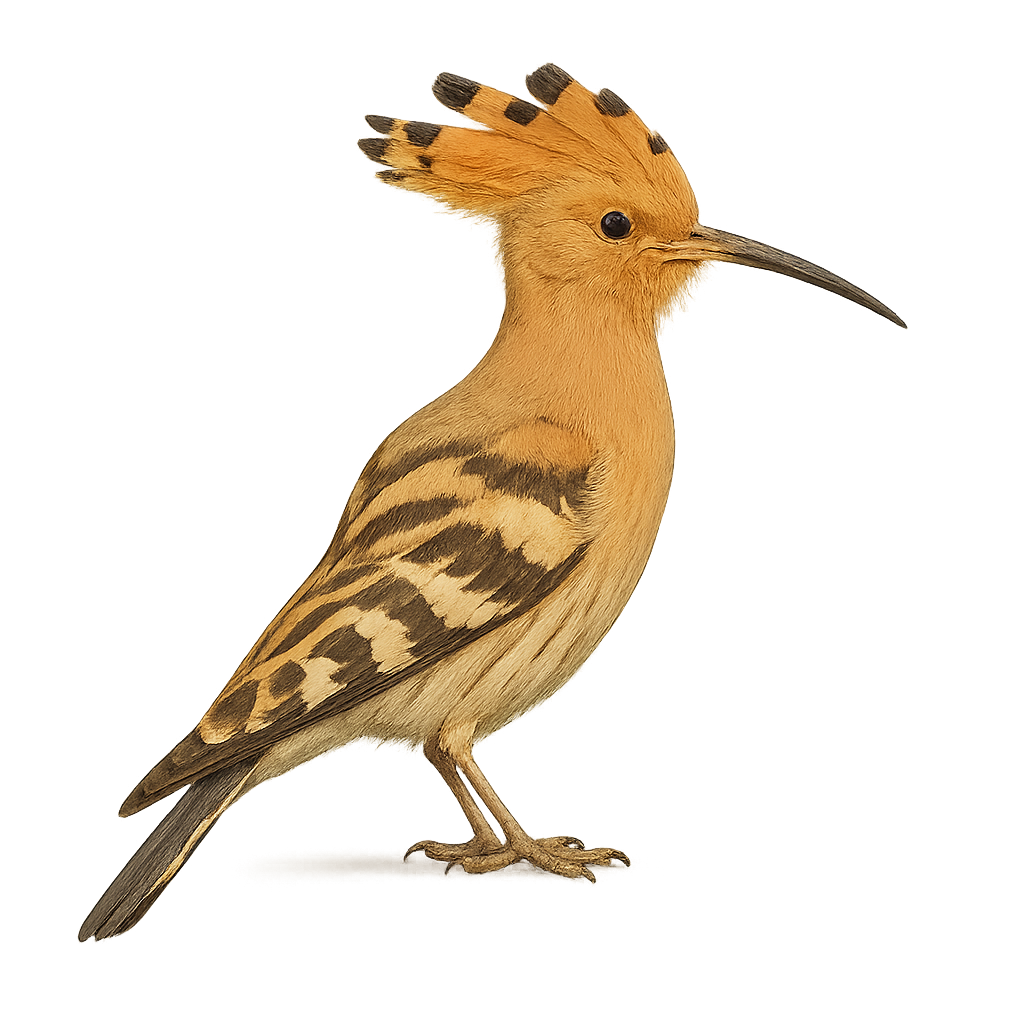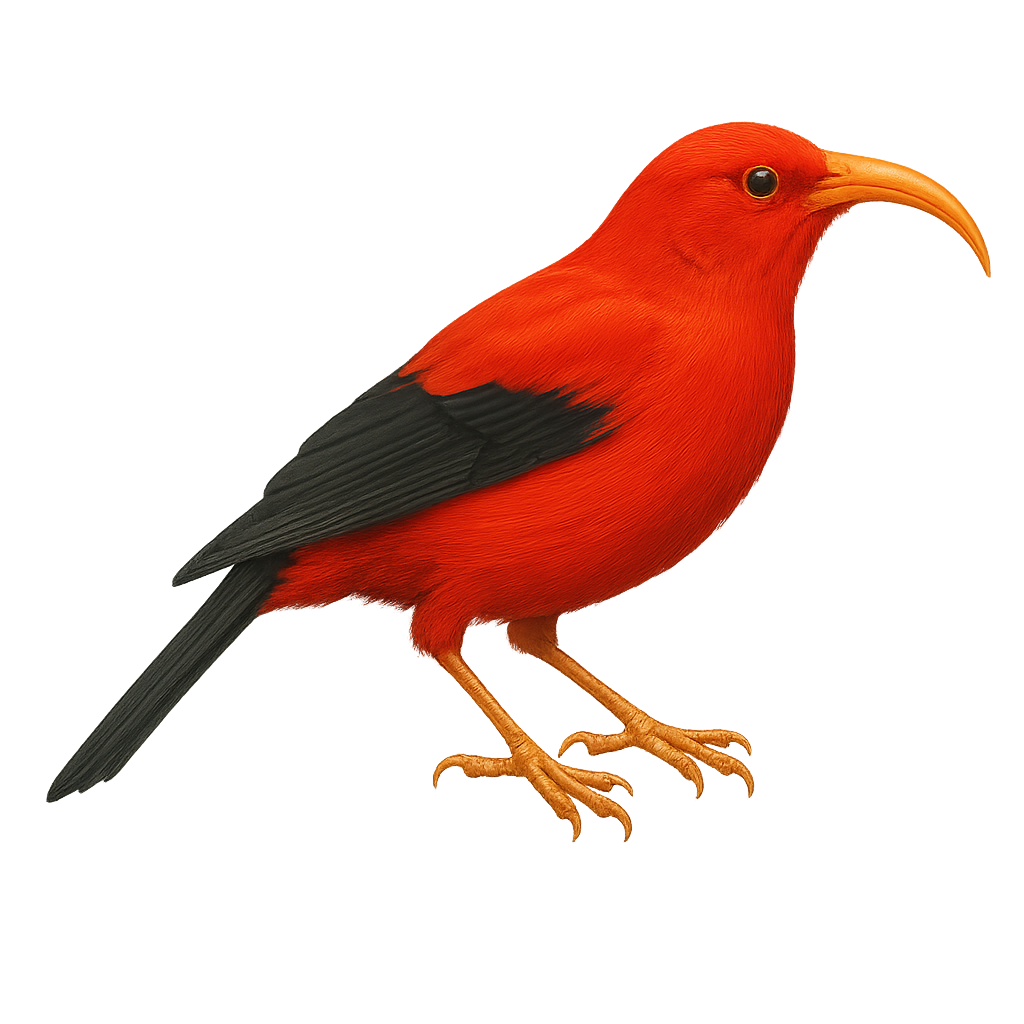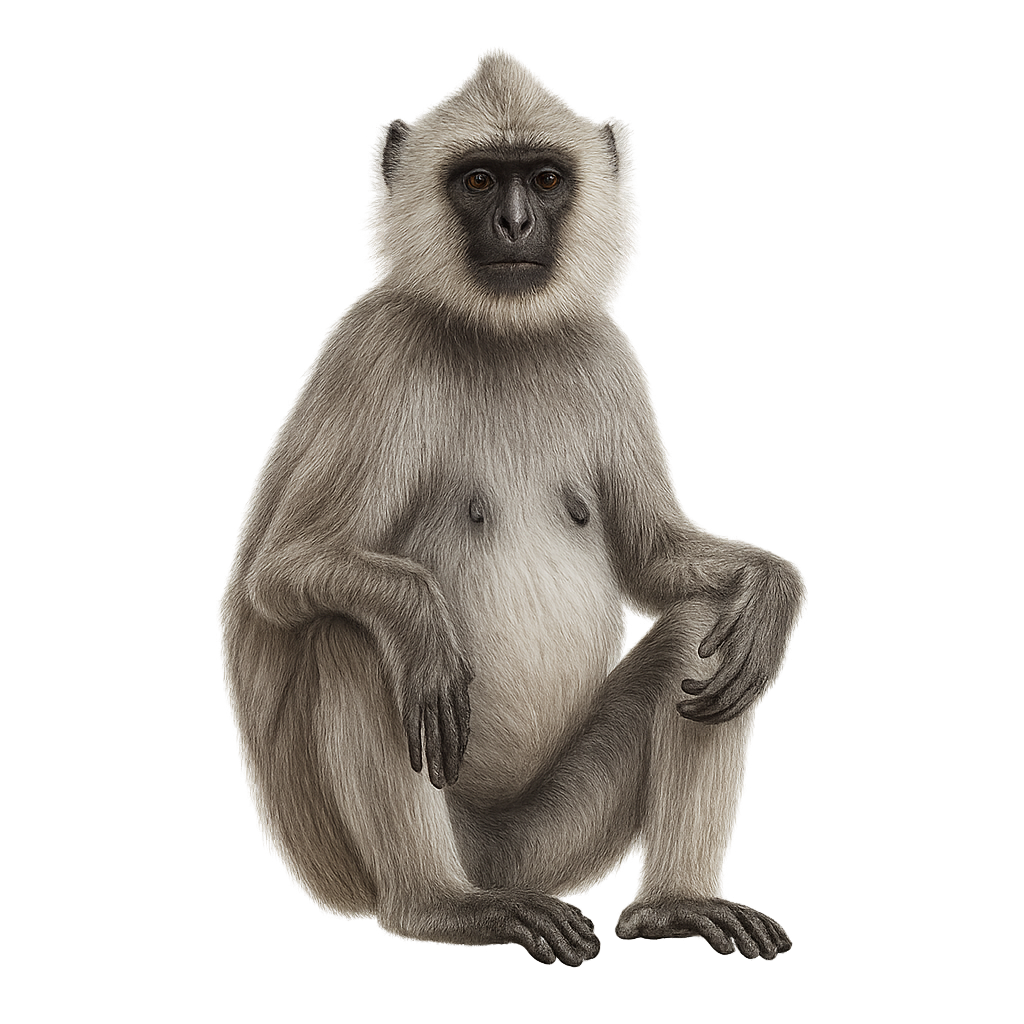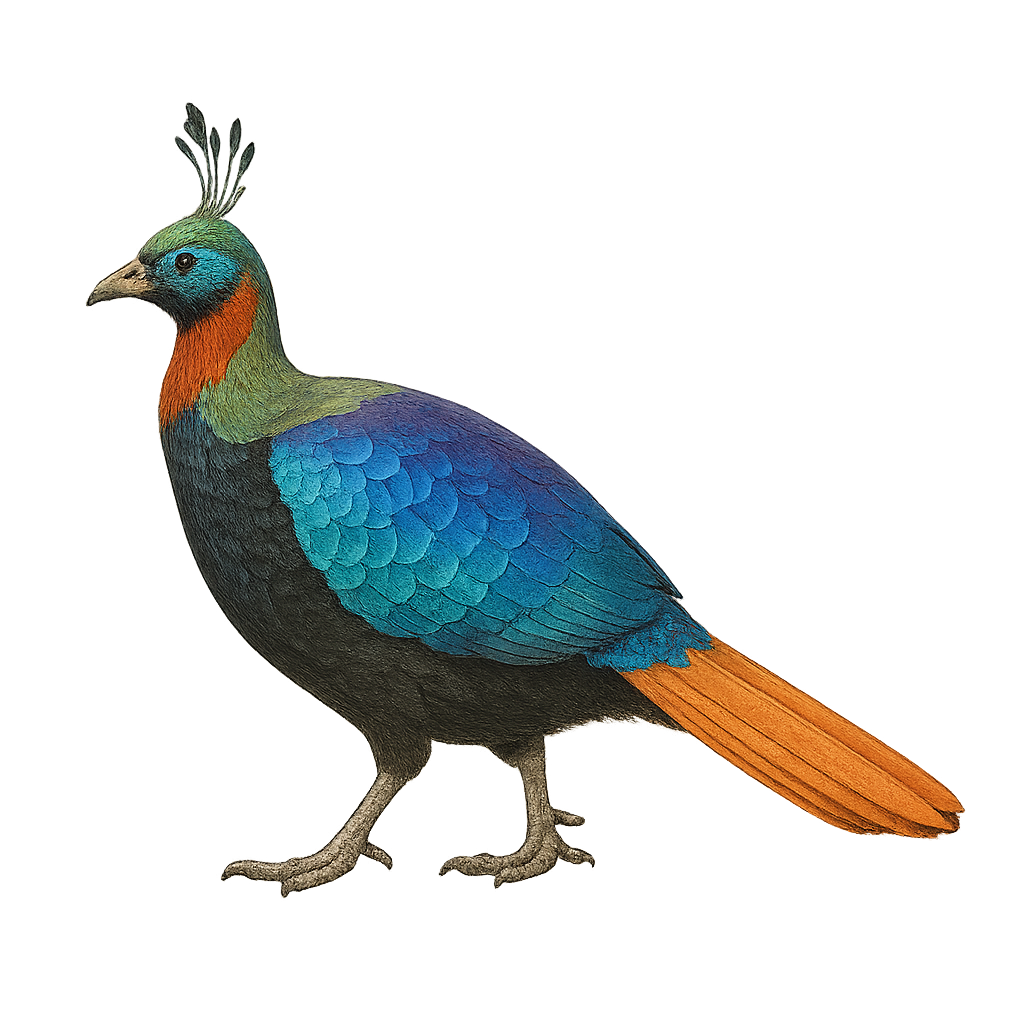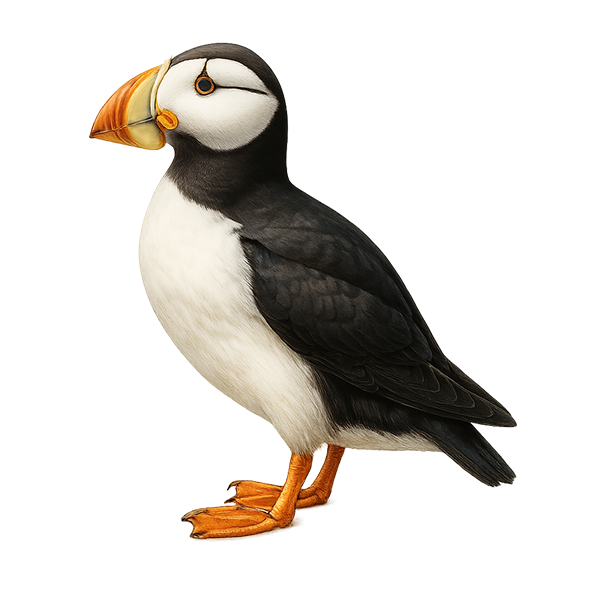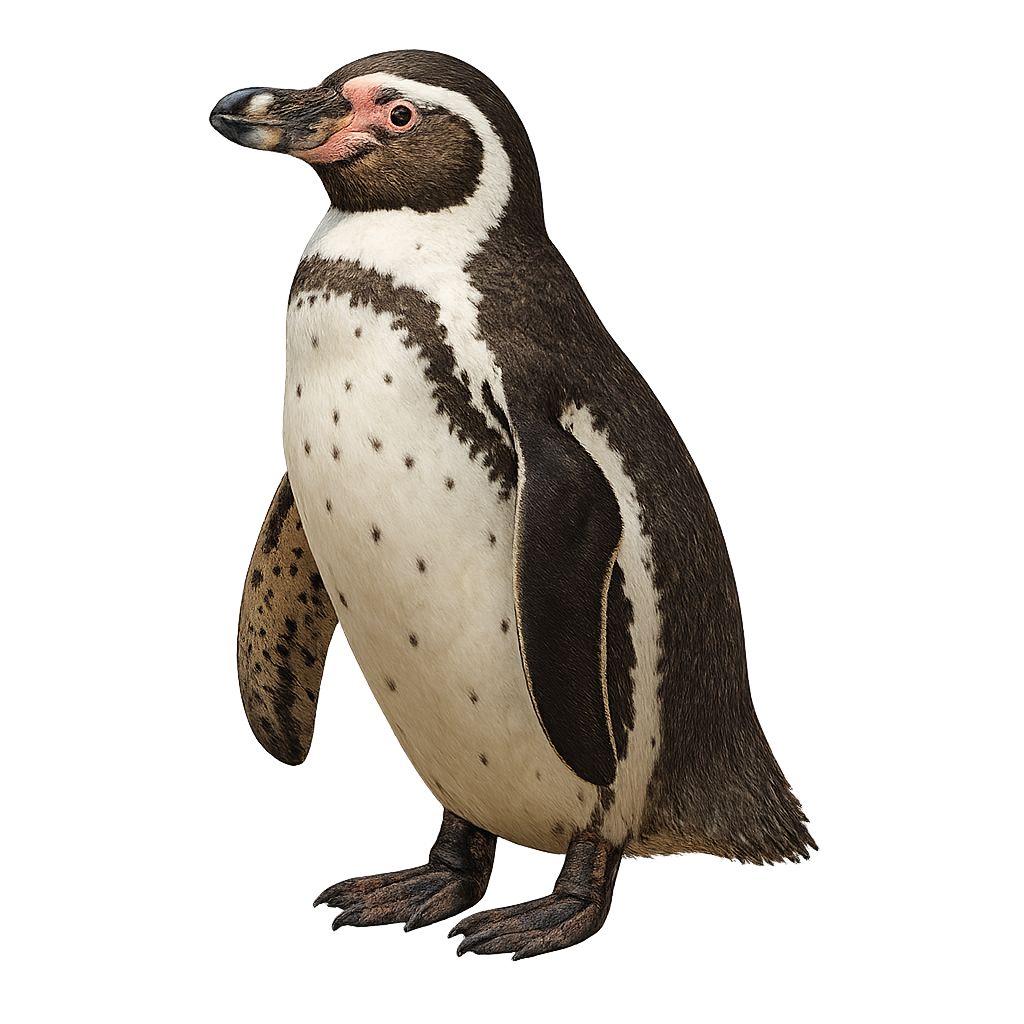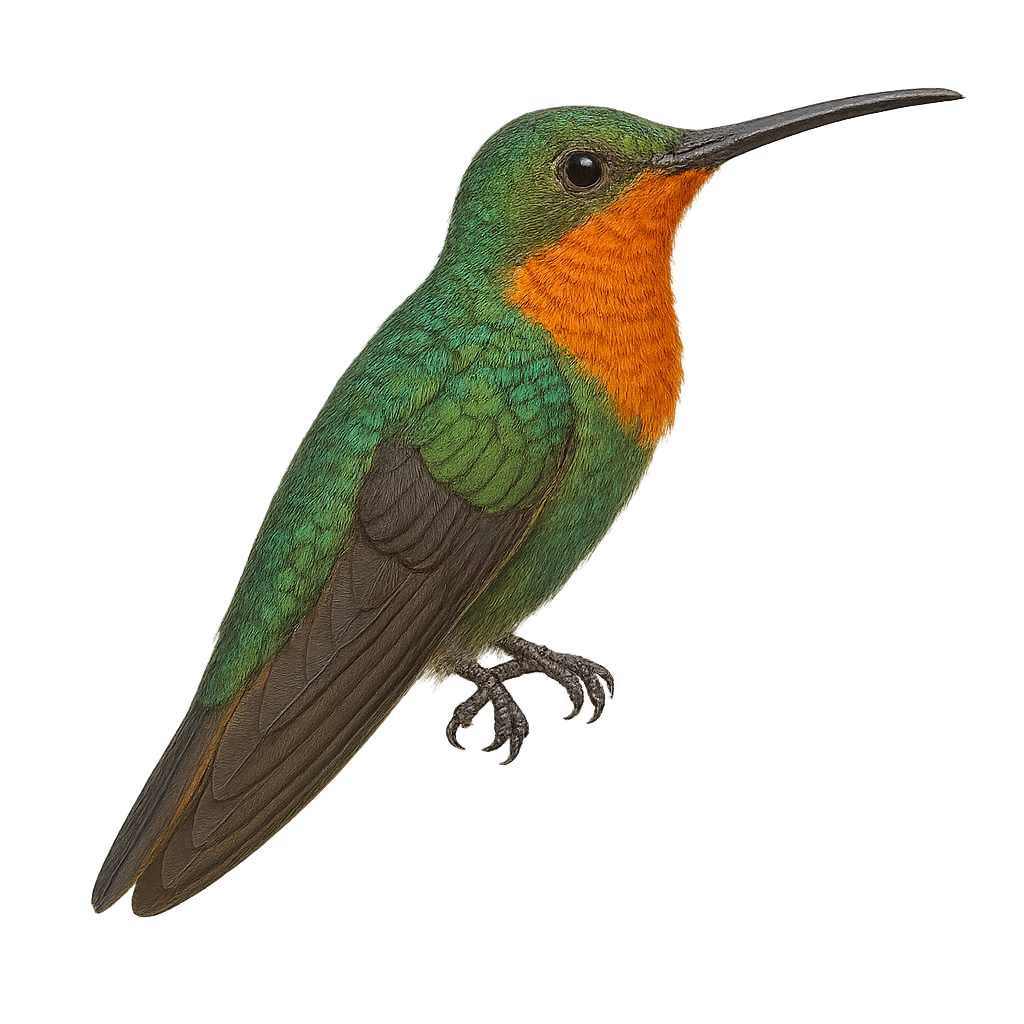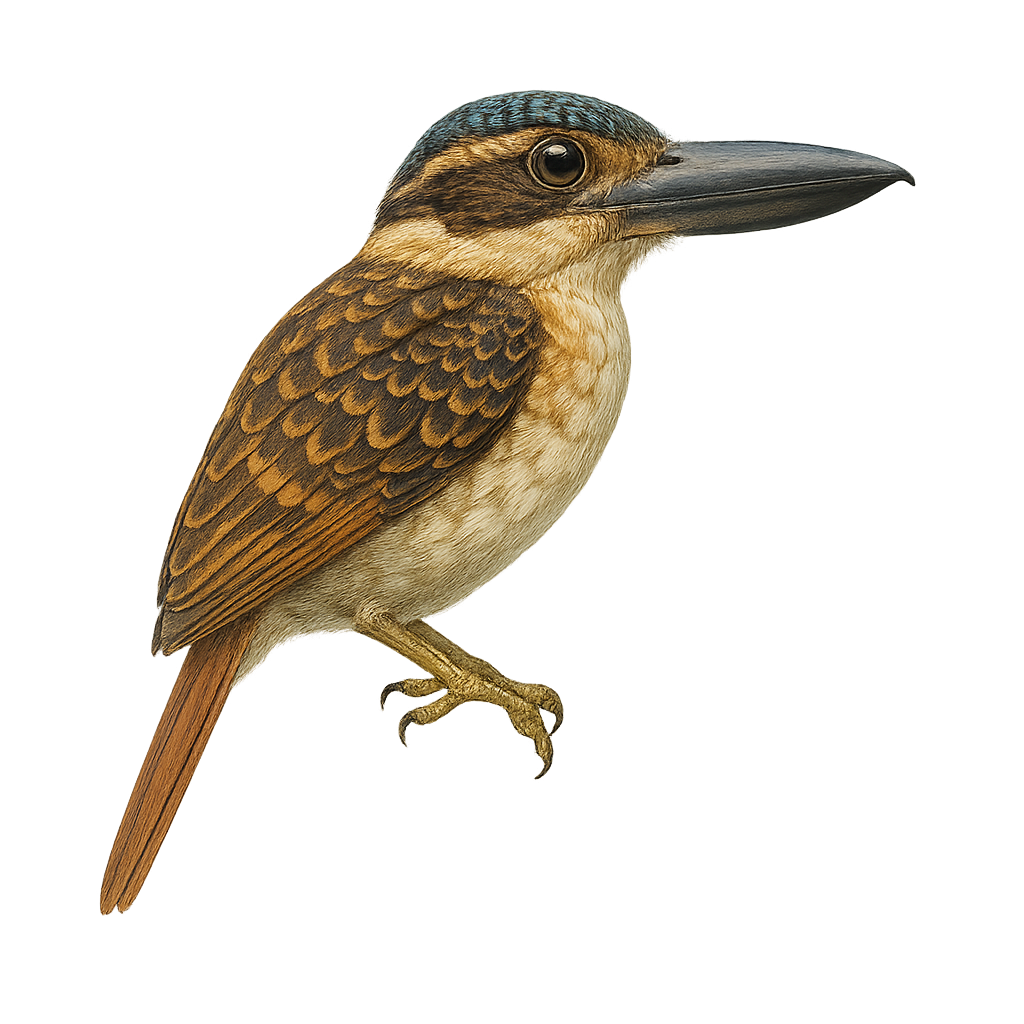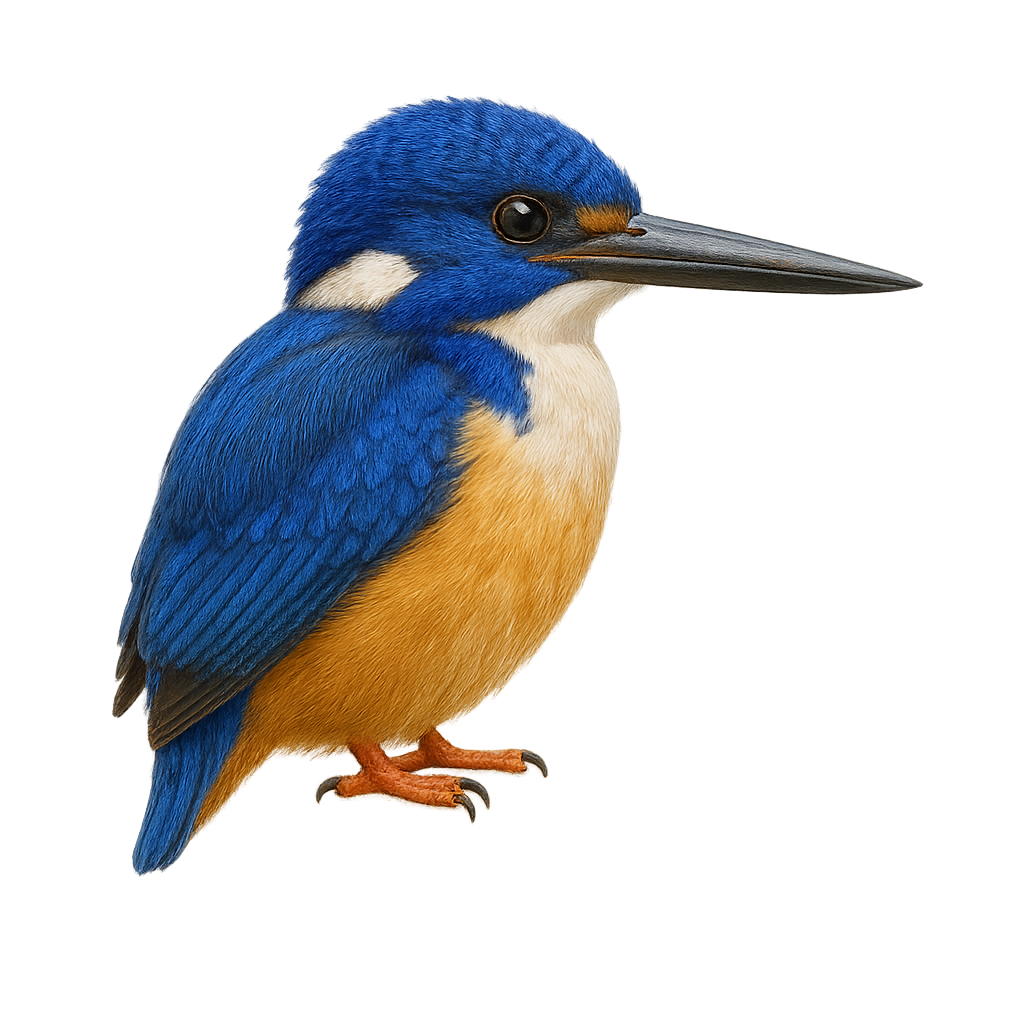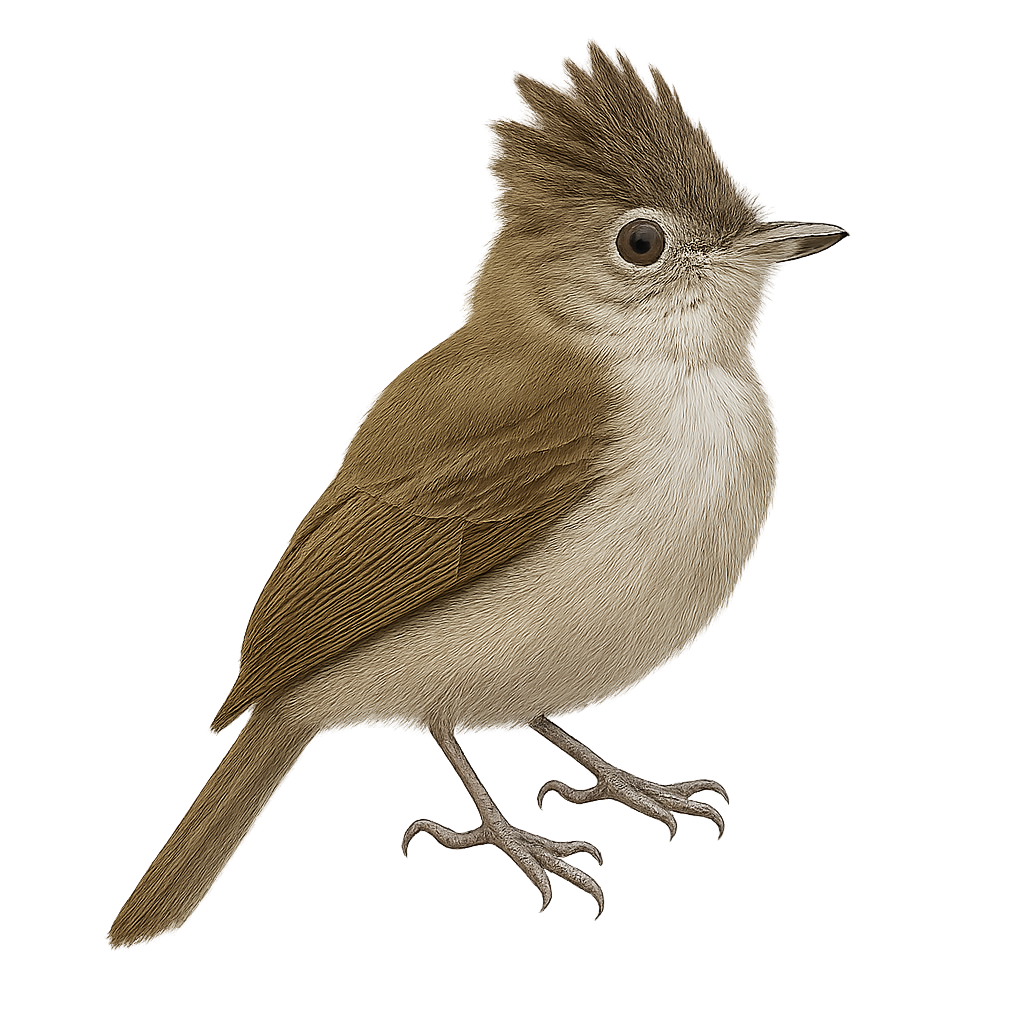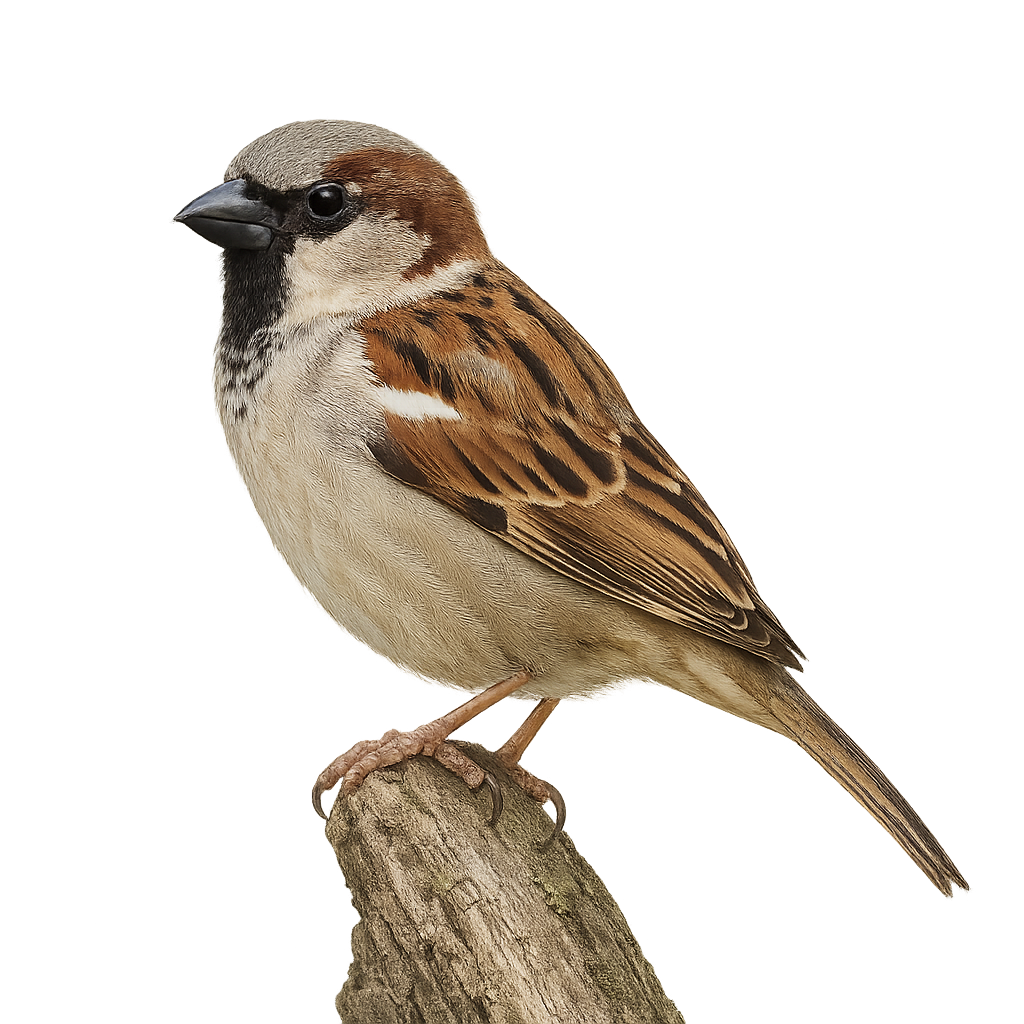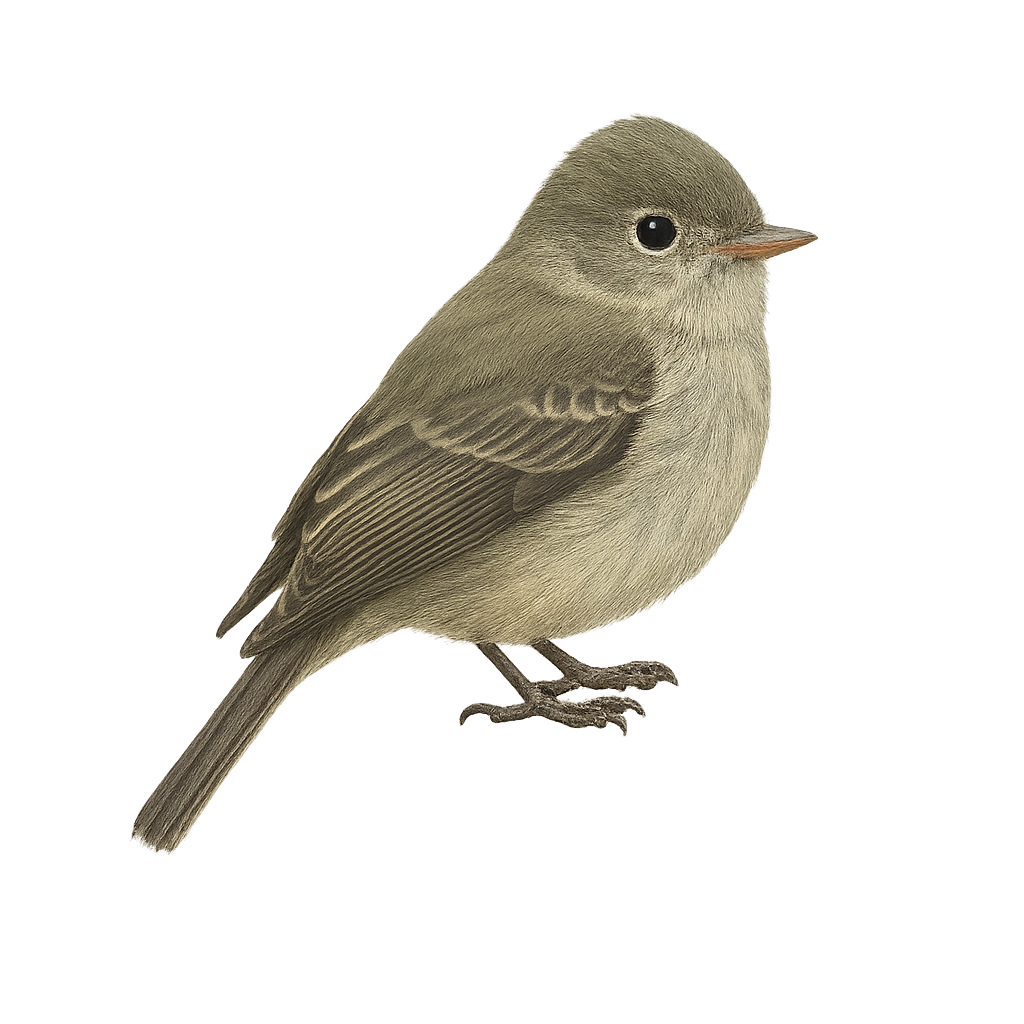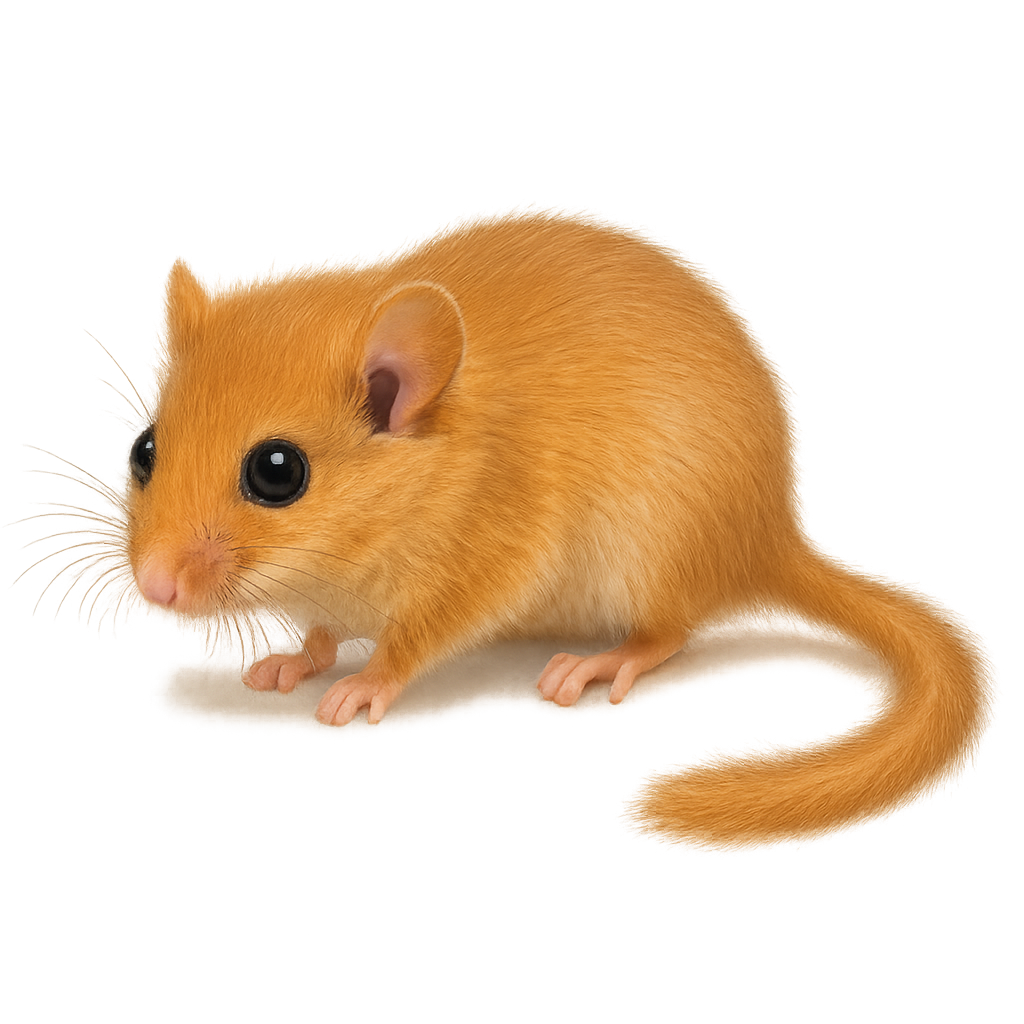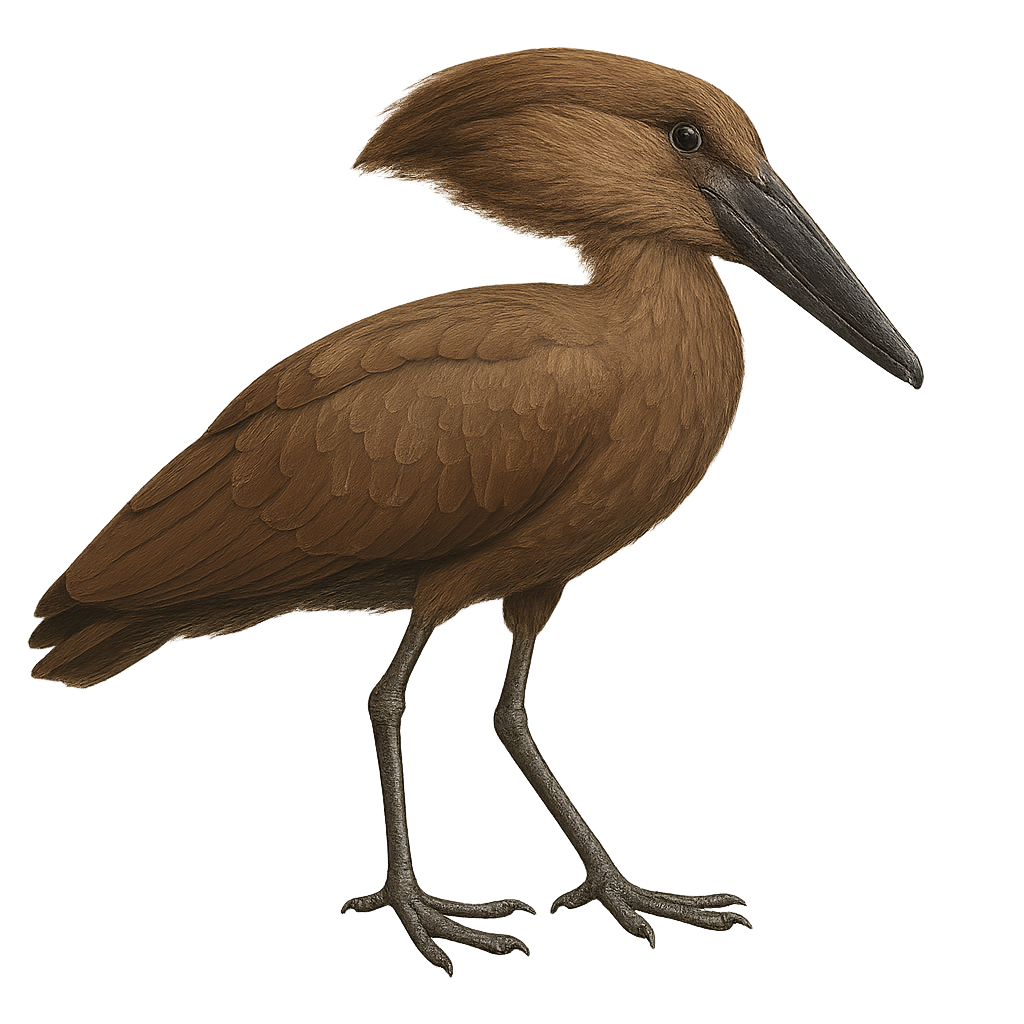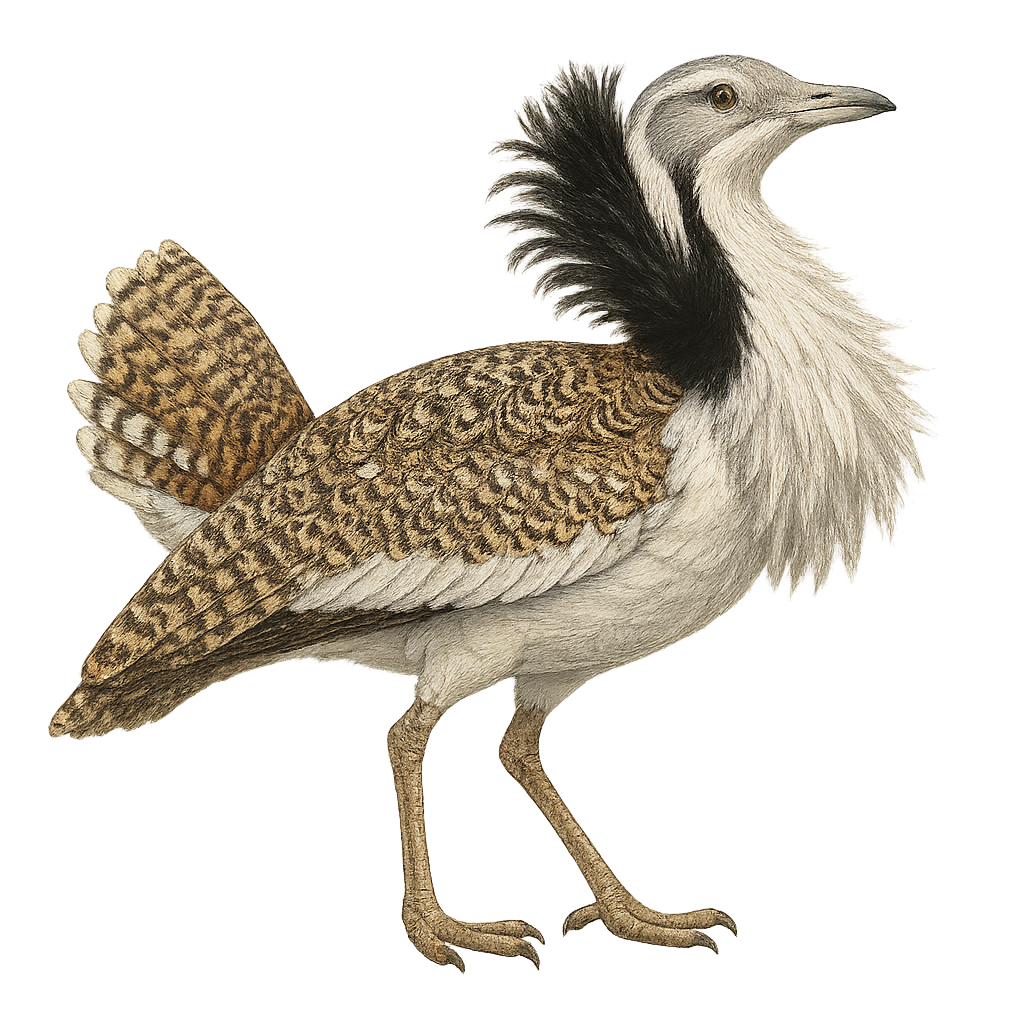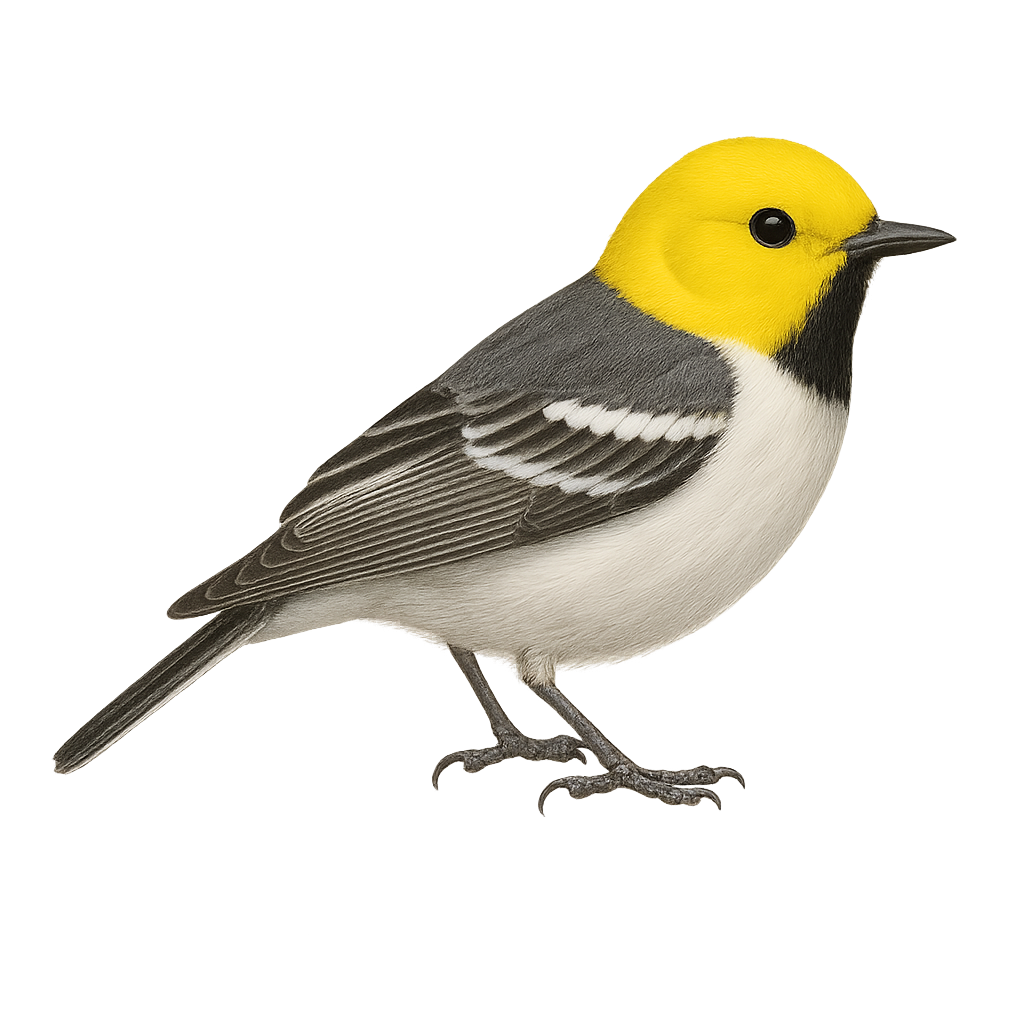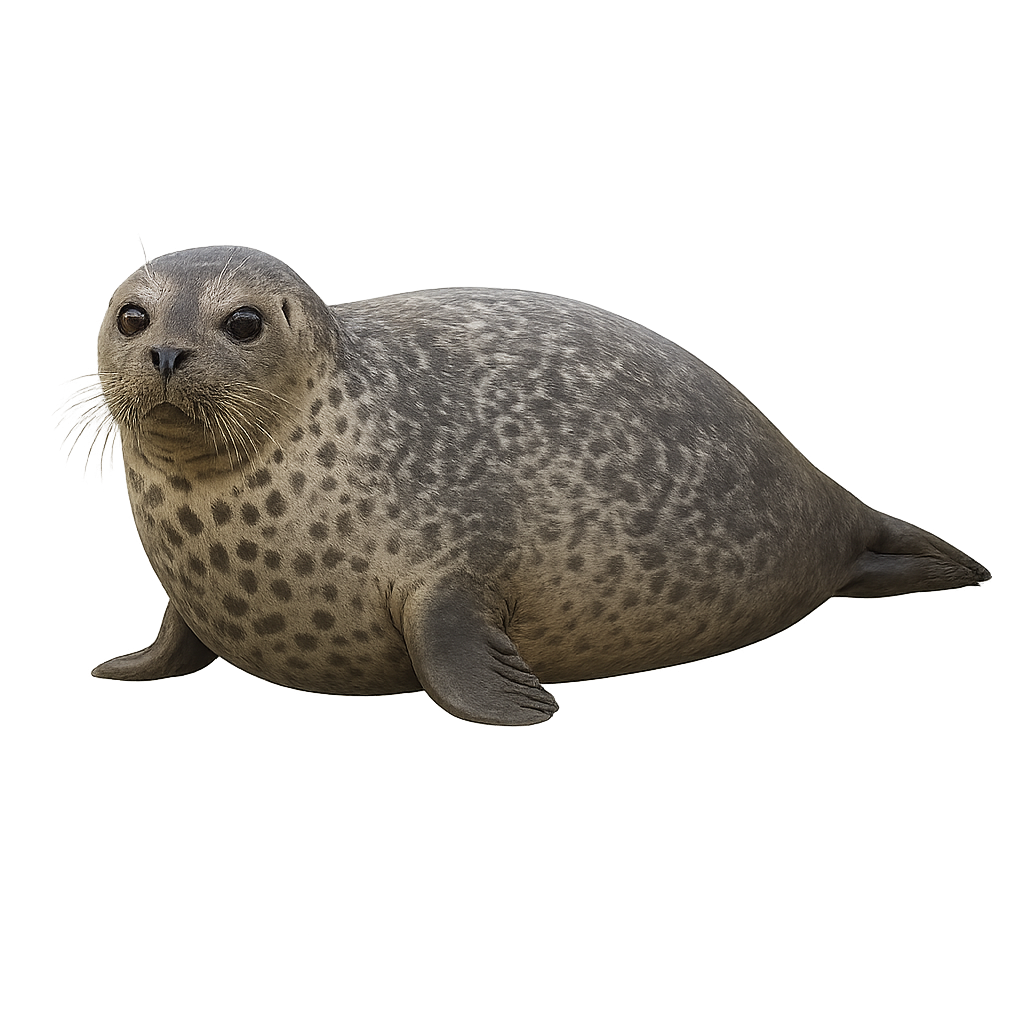The Hermit Thrush, or Catharus guttatus, is a medium-sized bird, measuring about 17 cm in length. It is recognizable by its olive-brown back and dark spots on its chest. Its melodious song is often heard in North American forests, where it primarily nests. It prefers wooded and moist habitats, often near streams. A migratory bird, it winters in the southern United States and Central America. Its diet is varied, including insects, berries, and fruits. Although discreet, it is often observed moving on the ground in search of food.
The Hawfinch is a small passerine bird with a very powerful beak, designed to crack hard seeds and kernels. It measures about 22 cm in length and weighs between 50 and 70 g. Its plumage is mainly brown and gray, with white markings and a black patch on the head, while its wings are black with distinct white spots. The beak is wide, conical, and very robust, and it is the most remarkable feature of the bird. The Hawfinch primarily inhabits forests and wooded gardens in Europe and Western Asia, notably in France, Germany, Russia, and Turkey. It primarily feeds on seeds, particularly fruit pits and tree seeds. Its behavior is rather discreet and solitary, although it can be seen in small groups during the winter months. While the species is not endangered, habitat loss and deforestation may pose potential threats.
The hamadryas baboon, also known as the sacred baboon, is a primate species distinguished by its silver fur and the impressive mane of the males. Native to the Horn of Africa and parts of the Arabian Peninsula, it lives in complex social groups. Dominant males lead harems consisting of several females and their offspring. These baboons are diurnal and spend most of their time foraging for food, primarily fruits, seeds, and insects. Their natural habitat includes savannas, arid steppes, and rocky areas. Although they can survive in harsh environments, their population is threatened by habitat loss and hunting.
The Hooded Merganser is a medium-sized duck, easily recognizable by its distinctive crest and vibrant colors. It measures about 40 to 50 cm in length, with a wingspan of 60 to 70 cm, and weighs between 400 and 700 g. The male, during the breeding season, has a black and white head with an impressive crest of white feathers on top. Its plumage is mainly black and white, with shades of brown and green, and it has a short, wide beak adapted for feeding on fish, crustaceans, and aquatic invertebrates. The female, on the other hand, is more subtle, with light brown plumage and a less prominent crest. The Hooded Merganser primarily inhabits North America, particularly in the northeastern United States, where it frequents lakes, rivers, and wetland areas. It is an excellent diver, capable of diving underwater to capture its prey. Although the species is not in immediate danger, it is vulnerable to habitat loss and water pollution.
The Harpy Eagle is one of the most powerful and impressive raptors in the world, easily recognizable by its large size and distinctive crest of feathers on its head. It measures between 86 and 107 cm in length, with a wingspan of 2 to 2.3 meters, and weighs between 6 and 10 kg. Its plumage is primarily dark gray and black, with white spots on the wings and belly, and a head adorned with a crest of feathers, giving it an imposing appearance. The Harpy Eagle primarily inhabits the tropical rainforests of Central and South America, notably in Mexico, Panama, Colombia, and Brazil. Carnivorous, it primarily feeds on mammals such as monkeys, sloths, and coatis, which it captures in flight or on trees with its powerful talons. Although the Harpy Eagle is not yet critically endangered, its population is threatened by deforestation, habitat loss, and illegal hunting.
The hirola, or Beatragus hunteri, is a rare and endangered antelope native to the dry savannas of Kenya and Somalia. Recognizable by its lyre-shaped horns and light brown coat, the hirola is often called the "four-eyed antelope" due to the prominent preorbital glands located under its eyes. These glands play a crucial role in olfactory communication among individuals. Hirolas live in small herds, usually consisting of females and their young, while adult males are often solitary or form small bachelor groups. This species is diurnal, feeding mainly on grasses and foliage. Unfortunately, the hirola is critically endangered, primarily due to habitat loss, hunting, and diseases transmitted by domestic livestock.
The house martin is a small migratory bird found mainly in urban and rural areas across Europe, Asia, and North Africa. It is easily recognized by its metallic blue back and its white throat and belly. This swallow builds its nest under roofs, on window ledges, and on building cornices. It primarily feeds on insects, which it catches mid-flight, often chasing swarms of insects at high speed.
The Hoatzin is a strange and fascinating bird, easily recognizable by its plume crest and distinctive plumage. Native to the tropical forests of South America, particularly in the Amazon Basin, this bird stands out for its leaf-based diet, which it digests through fermentation in its digestive system, a process similar to that of ruminants. It has short wings and prefers to move by hopping through trees or swimming. While not aggressive, the Hoatzin is a shy bird and difficult to observe, often hidden in dense vegetation.
The Helmeted Curassow, or Pauxi pauxi, is a large terrestrial bird from the Cracidae family, primarily found in the humid tropical forests of the Andes in Venezuela and Colombia. It is distinguished by its unique horned crest, which gives it its name. This curassow is black with bluish sheen and a white chest. It feeds mainly on fruits, seeds, and insects. Unfortunately, it is threatened by habitat loss and hunting. Its discreet nature and dark plumage make it difficult to observe in its natural environment. Conservation efforts are crucial to ensure its long-term survival.
The huemul is a species of deer native to the mountains of Patagonia, in Argentina and Chile. It is distinguished by its medium size and graceful antlers. It lives in mountain forests, where it primarily feeds on plants, moss, and bark. Unfortunately, it is classified as endangered due to illegal hunting and habitat loss. The huemul is a symbol of the region's wildlife, but its populations are becoming increasingly rare.
The Eurasian Hoopoe is a bird with a spectacular plumage, easily recognizable by its colorful crest of feathers that it raises in the shape of a tuft on its head. It measures about 25 to 29 cm in length, with a wingspan of 44 to 48 cm, and weighs between 40 and 70 g. Its plumage is primarily light beige, with black and white stripes on the back and wings, and its beak is long, thin, and slightly curved, ideal for probing the ground in search of insects and other small prey. The Eurasian Hoopoe primarily inhabits open areas, such as grasslands, orchards, forest edges, and cultivated areas across Europe, Asia, and North Africa. It mainly feeds on insects, such as ants, termites, and larvae, which it catches by probing the ground. This bird is an excellent flier, capable of flying long distances with powerful wingbeats. Although the species is not endangered, it is vulnerable to habitat loss and the intensification of agriculture.
The Hadada Ibis, or Bostrychia hagedash, is a medium-sized bird known for its metallic brown-green plumage and distinctive call, often heard at dusk. Native to sub-Saharan Africa, it inhabits wetlands, grasslands, and open forests. This gregarious bird primarily feeds on insects, worms, and small invertebrates, which it probes from the ground with its long, curved bill. It is often seen in groups, especially during breeding seasons. Although generally tolerant of human presence, it can become wary if disturbed. The Hadada Ibis plays a crucial role in the ecosystem by controlling insect populations and aiding in seed dispersal.
The iiwi, or Drepanis coccinea, is an iconic bird of the Hawaiian forests. With its bright red plumage and black wings, it is easily recognizable. This bird measures about 15 cm in length and has a curved beak, adapted for collecting nectar, its primary food source. The iiwi plays a crucial role in pollinating native plants. Unfortunately, it is threatened by habitat loss, avian diseases, and introduced predators. Conservation efforts aim to protect its natural habitats and control invasive species. The iiwi is often observed in wet forests at various altitudes, where it moves agilely in search of flowers.
The Semnopithecus entellus, commonly known as the Hanuman Langur, is a medium-sized primate native to the Indian subcontinent. It is easily recognizable by its silver-grey fur and black, hairless face. These monkeys live in complex social groups, often consisting of multiple females and a few males. They are primarily arboreal but frequently descend to the ground to forage. Their diet is varied, including leaves, fruits, flowers, and sometimes insects. Grey langurs are known for their adaptability to different habitats, ranging from tropical forests to urban areas. Their social behavior is fascinating, with complex interactions and well-established hierarchies.
The Himalayan Monal, or Lophophorus impejanus, is a striking bird native to the mountainous regions of the Himalayas. Known for its iridescent plumage, the male displays a dazzling array of metallic blues, greens, and purples, while the female is more subdued with mottled brown feathers for camouflage. These birds inhabit coniferous forests and alpine meadows, feeding on roots, tubers, and insects. Although capable of flight, they prefer to walk or run on the ground. Their call is a sharp, resonant cry that echoes through the mountain valleys.
The Horned Puffin, Fratercula corniculata, is a striking seabird known for its colorful bill and distinctive black feather "horns" above its eyes. It primarily inhabits the northern Pacific coasts, especially in Alaska and eastern Russia. This bird is well adapted to marine life, spending most of its time at sea, feeding on fish and small invertebrates. During the breeding season, it nests in rocky crevices on steep cliffs. The Horned Puffin is an excellent diver, capable of descending several tens of meters underwater to catch its prey. Although its populations are currently stable, it is sensitive to climate change and marine pollution.
The Humboldt penguin is a medium-sized penguin (56–70 cm, 2.9–6 kg) with dark grey upperparts, a white belly, and a black head bordered by a white band around the eye. It is endemic to the Pacific coast of South America (Peru and Chile), nesting in guano burrows, rocky crevices, and coastal caves. Social, it forms small colonies on islands and coastal cliffs.
The Hispaniolan Mango, or Anthracothorax dominicus, is a captivating bird primarily found on the island of Hispaniola, shared by Haiti and the Dominican Republic. This hummingbird is recognizable by its vibrant plumage, featuring metallic green and blue hues. Males often display an iridescent throat, while females are slightly duller. They primarily feed on nectar but also consume small insects to supplement their diet. These birds are often seen in gardens, tropical forests, and wooded areas, where they play a crucial role in plant pollination. Their fast and agile flight is a spectacle to behold, especially when they defend their territory against other hummingbirds.
The Melidora macrorrhina, commonly known as the Hook-billed Kingfisher, is a fascinating bird native to the tropical forests of New Guinea. This kingfisher is distinguished by its unique, wide, and flattened bill, which allows it to effectively capture aquatic prey. It sports a vibrant plumage with shades of blue, green, and white, giving it an elegant appearance. This bird prefers dense, humid habitats where it can hide among the foliage while watching for prey. Although primarily solitary, it is sometimes observed in small family groups. Its discreet presence and suspicious behavior make it difficult to spot, but it is a true gem for birdwatchers and passionate photographers.
The Half-collared Kingfisher, Alcedo semitorquata, is a captivating bird found in the tropical regions of sub-Saharan Africa. It is notable for its vibrant blue plumage on the back and wings, contrasting with a white belly and a blue chest band. Its head features a dark blue crown, and its long black bill is perfect for catching fish, its primary food source. This kingfisher inhabits rivers, lakes, and wetlands, where it can be seen perched on branches overhanging the water, ready to dive for its prey. Though discreet, it is often detected by its sharp, piercing call.
The Lophotriccus galeatus, or Helmeted Pygmy-Tyrant, is a small passerine bird belonging to the Tyrannidae family. It is recognizable by its distinctive crest, often raised, giving it a unique appearance. Its plumage is primarily olive green with yellowish tones on the belly. This bird mainly inhabits the humid tropical forests of South America, especially in Brazil, Colombia, and Venezuela. It is often observed in dense undergrowth where it feeds on insects. Despite its small size, it is very active and agile, moving quickly through the foliage. Its song is a high-pitched trill that resonates in the canopy.
The house sparrow is a very common small bird, found primarily in urban environments, gardens, fields, and parks. It is easily recognized by its brown plumage, grey head, and black markings on its back and chest. This passerine bird is omnivorous, feeding on seeds, insects, and food scraps. Although highly social and often seen in large numbers, the house sparrow is in decline in some regions due to habitat loss and climate change.
The Hammond's Flycatcher, or Empidonax hammondii, is a small passerine bird belonging to the Tyrannidae family. It is primarily found in the coniferous forests of North America, especially in mountainous regions. This flycatcher is characterized by its gray-olive plumage, lighter belly, and wings marked with two white wing bars. Its beak is relatively short and dark, suitable for its insectivorous diet. During the breeding season, it builds its nest in trees, often at considerable heights. Its song is a key element for identification, consisting of a series of high-pitched, repetitive notes. Although discreet, it is often detected by its distinctive song.
The Common Dormouse is a small nocturnal rodent, often compared to a miniature squirrel, found mainly in forests, hedgerows, and gardens across Europe. It measures about 7 to 9 cm in length, with a tail of 5 to 7 cm, and weighs between 15 and 30 g. Its coat is typically brown or gray with a light belly, and it has large black eyes and round ears. The Common Dormouse is an arboreal and nocturnal animal that primarily feeds on fruits, seeds, nuts, and sometimes insects. It is an excellent climber, often living in trees or natural cavities. This small rodent is known for its hibernation behavior: it enters torpor during the winter months, retreating into its nest to survive the cold temperatures. Although it is widespread, it is threatened by habitat loss and human disturbances.
The Hamerkop, or Scopus umbretta, is a unique and fascinating bird, recognizable by its distinctive hammer-shaped head. It measures about 50 cm in length and has a uniform brown plumage. This bird is often seen near water bodies in sub-Saharan Africa, where it builds massive nests weighing up to 50 kg. The Hamerkop is a gregarious bird, often seen in small groups, and feeds primarily on fish, amphibians, and aquatic insects. It is known for its elaborate courtship behavior, which includes dances and twig offerings. Although its conservation status is currently "least concern," habitat degradation could pose future threats.
The Ursus arctos isabellinus, commonly known as the Himalayan brown bear, is a subspecies of the brown bear found primarily in the mountainous regions of the Himalayas. These bears are large, with thick fur that ranges from light brown to dark brown, sometimes with reddish hues. They are omnivorous, feeding on plants, insects, and small mammals. Their natural habitat includes alpine meadows and subalpine forests. Due to hunting and habitat loss, their population is declining, making them vulnerable. They are solitary except during the breeding season and when a mother is raising her cubs.
The Houbara bustard, Chlamydotis undulata, is a medium-sized bird known for its sandy-brown plumage, which provides excellent camouflage in desert landscapes. It features a distinctive crest of black and white feathers on its head and neck. This primarily terrestrial bird prefers running to flying when escaping predators. Its diet consists mainly of plants, insects, and small reptiles. The Houbara bustard is famous for its spectacular courtship displays, where the male fans out his feathers to attract a mate. It inhabits the arid and semi-arid regions of North Africa, the Middle East, and Central Asia. Unfortunately, this species is threatened by excessive hunting and habitat loss.
The Two-toed Sloth is an arboreal mammal native to the tropical forests of Central and South America, notably in Costa Rica, Panama, Colombia, and Ecuador. It measures between 50 and 60 cm in length, with a reduced tail and weighs between 4 and 8 kg. Its fur is long, thick, and gray-green in color, allowing it to blend into the foliage of trees. As its name suggests, it has two toes on its front limbs, which allow it to cling to branches and move slowly from tree to tree. The Two-toed Sloth is primarily herbivorous, feeding on leaves, fruits, and flowers. Although it is an excellent climber, it moves very slowly and often only leaves its trees once a week to descend to the ground for defecation. The species is currently listed as "vulner
The Hermit Warbler is a small songbird in the Parulidae family, easily identified by its distinctive plumage. It has a black back, wings striped with white, and a black throat contrasting with its white belly. Males display a yellow spot on the cheek, while females have a duller hue. It primarily inhabits coniferous and mixed forests in western North America. A migratory bird, it winters in the southwestern United States and Mexico. Its song is a soft, melodious trill, often heard in spring. It feeds mainly on insects, which it catches by flitting agilely among branches.
The Common Seal, also known as the Harbor Seal, is a marine mammal found primarily along the coasts of the North Atlantic, in Europe and North America. It measures between 1.5 and 2 meters in length and weighs between 60 and 150 kg. Its fur is typically light gray with dark spots, and its head is rounded with bright black eyes. The Common Seal is an excellent swimmer and primarily feeds on fish, crustaceans, and mollusks. It is often seen lounging on rocks or beaches. Although its population remains relatively stable, the Common Seal is sometimes threatened by pollution, hunting, and human disturbance of its breeding habitats.



